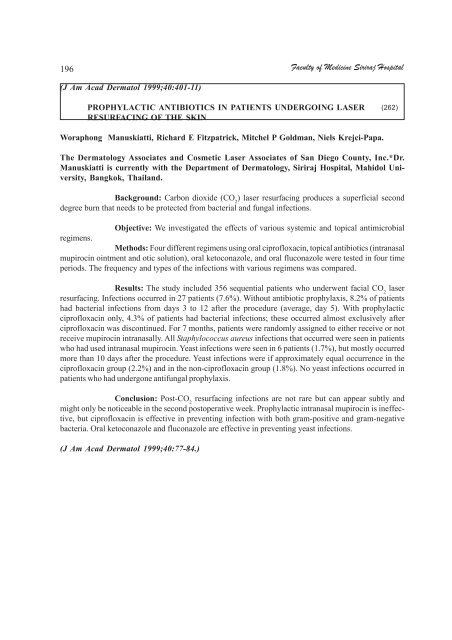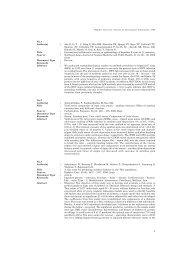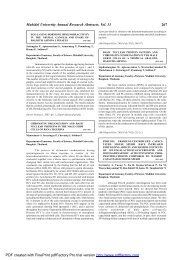THE OSTIA VENAE HEPATICAE AND THE RETHROHEPATIC ...
THE OSTIA VENAE HEPATICAE AND THE RETHROHEPATIC ...
THE OSTIA VENAE HEPATICAE AND THE RETHROHEPATIC ...
You also want an ePaper? Increase the reach of your titles
YUMPU automatically turns print PDFs into web optimized ePapers that Google loves.
196<br />
(J Am Acad Dermatol 1999;40:401-11)<br />
PROPHYLACTIC ANTIBIOTICS IN PATIENTS UNDERGOING LASER<br />
RESURFACING OF <strong>THE</strong> SKIN<br />
Woraphong Manuskiatti, Richard E Fitzpatrick, Mitchel P Goldman, Niels Krejci-Papa.<br />
The Dermatology Associates and Cosmetic Laser Associates of San Diego County, Inc.*Dr.<br />
Manuskiatti is currently with the Department of Dermatology, Siriraj Hospital, Mahidol University,<br />
Bangkok, Thailand.<br />
Background: Carbon dioxide (CO 2 ) laser resurfacing produces a superficial second<br />
degree burn that needs to be protected from bacterial and fungal infections.<br />
Objective: We investigated the effects of various systemic and topical antimicrobial<br />
regimens.<br />
Methods: Four different regimens using oral ciprofloxacin, topical antibiotics (intranasal<br />
mupirocin ointment and otic solution), oral ketoconazole, and oral fluconazole were tested in four time<br />
periods. The frequency and types of the infections with various regimens was compared.<br />
Results: The study included 356 sequential patients who underwent facial CO 2 laser<br />
resurfacing. Infections occurred in 27 patients (7.6%). Without antibiotic prophylaxis, 8.2% of patients<br />
had bacterial infections from days 3 to 12 after the procedure (average, day 5). With prophylactic<br />
ciprofloxacin only, 4.3% of patients had bacterial infections; these occurred almost exclusively after<br />
ciprofloxacin was discontinued. For 7 months, patients were randomly assigned to either receive or not<br />
receive mupirocin intranasally. All Staphylococcus aureus infections that occurred were seen in patients<br />
who had used intranasal mupirocin. Yeast infections were seen in 6 patients (1.7%), but mostly occurred<br />
more than 10 days after the procedure. Yeast infections were if approximately equal occurrence in the<br />
ciprofloxacin group (2.2%) and in the non-ciprofloxacin group (1.8%). No yeast infections occurred in<br />
patients who had undergone antifungal prophylaxis.<br />
Conclusion: Post-CO 2 resurfacing infections are not rare but can appear subtly and<br />
might only be noticeable in the second postoperative week. Prophylactic intranasal mupirocin is ineffective,<br />
but ciprofloxacin is effective in preventing infection with both gram-positive and gram-negative<br />
bacteria. Oral ketoconazole and fluconazole are effective in preventing yeast infections.<br />
(J Am Acad Dermatol 1999;40:77-84.)<br />
Faculty of Medicine Siriraj Hospital<br />
(262)

















